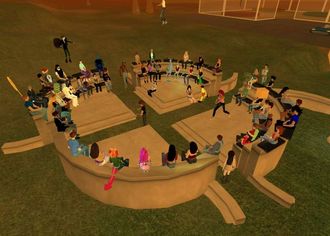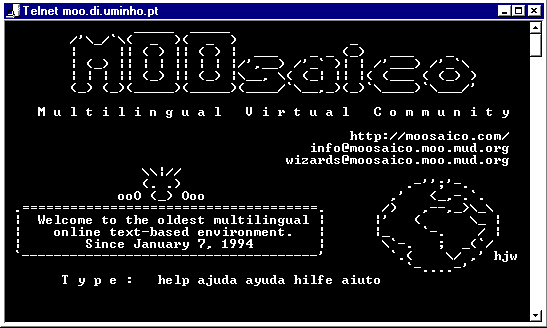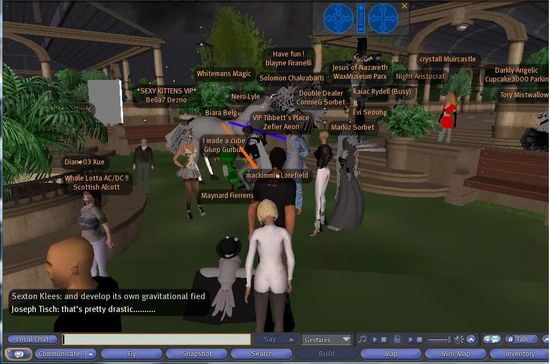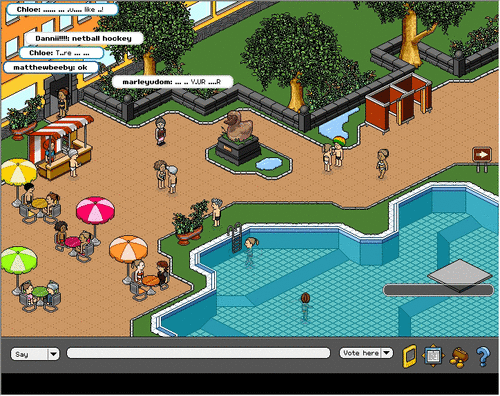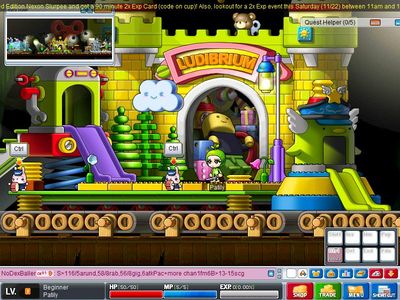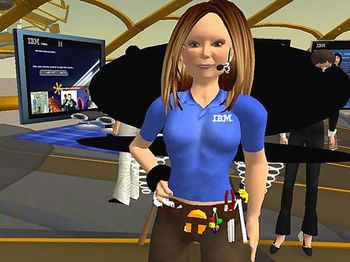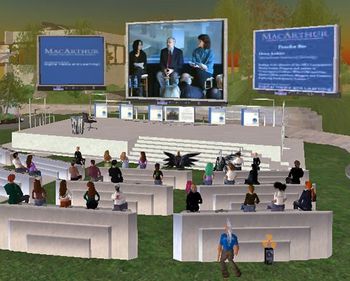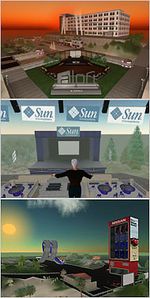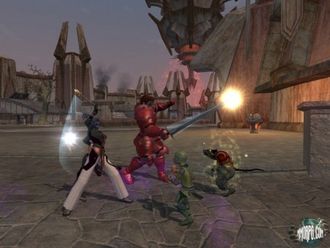T13 GROUP5
Contents
- 1 Project Title: Real Life in Virtual Worlds
- 2 Project Statement
- 3 Overview of Virtual Worlds
- 4 History of Virtual Worlds
- 5 Second Life a Virtual World
- 6 Habbo Hotel
- 7 Maple Story
- 8 Advancements In Technology
- 9 Social Advantages of Virtual Worlds
- 10 Disadvantages of Virtual Worlds
- 11 References
- 12 TA Comments
Project Title: Real Life in Virtual Worlds
Created by Lily Liu, Patricia Wang, James Yuen and Calendula Chan
Powerpoint Presentation:Project Statement
Our focus is on avatar computing. We will focus on the technology of avatar virtual worlds, where it allows people to create their alter egos and portray them in a computer game. Each character in the virtual world is capable of performing all tasks and living a virtual life as if it were in real life. Although this may be a creative outlet for social networking and a temporary escape from the real world, we will look at the possible dangers that this may cause. As well we will look at what virtual worlds are comprised of, and the technology that is involved.
Overview of Virtual Worlds
Virtual Worlds are a computer simulated environment where it's accessed by many people as users through online interfaces. When people become users in a virtual world they create a graphical character called an avatar representing them. Virtual Worlds are also known as digital worlds, simulated worlds and MMOG’s (Massive Multiplayer Online Games). These virtual worlds began in 2D virtual environments to currently 3D graphical virtual environments. Most virtual worlds are free to join however some of them require a small payment. These payments that users may encounter are either a member fee or to buy accessories for your avatar (ex. buying a shirt for your character to wear). Virtual worlds are considered a second life as many real life activities are able to occur in these online virtual worlds. From the time it was created many designers have created a variety of virtual worlds for people in all ages to join.
Features of Virtual Worlds
As there are a variety of virtual worlds to accessed through the internet, these online environments have similar features, which are
- Graphical User Interface: these worlds are visually formatted as 2D or 3D environments
- Interactivity: In the worlds users are able to change, build, develop or submit their own designs of the environment
- Immediately: Ihe worlds are happening in real time therefore the interaction in them are for real
- Persistence: Whether you are logged or not, the world just keeps running
- Shared space: Anyone is allowed to become involved in these worlds
- Socialization/Community Building: The worlds are created to encourage people with similar interests or to come together in becoming like a group, team or club where they can meet and interact with people
Purposes of Virtual Worlds
The main reason for web designers to develop these virtual worlds online is to create a Massive Multiplayer Online Role Playing Game (MMORPG). This main purpose is also the main type of virtual worlds. However, not all virtual worlds are made for people to play games there are other purposes to them, they are:
- Gaming: As gaming is the main reason for virtual worlds, the part they play in the gaming world is they create commercial gaming worlds, such as World of Warcraft, Everquest, Diablo and many more. These commercial gaming worlds are focused on genres such as fantasy, science fiction and literature or film. Using these genres in producing these games, the users create characters (avatar’s) that they control to move through a narrative storyline and special events.
- Socializing/Online Community Building: There are some virtual worlds that are created to socialize rather than gaming. They are similar to a chart room as the creations of these virtual worlds were influenced by the original text based chat rooms. In these social virtual worlds people are able to play mini games with other people and host activities and events.
- Education: Some virtual worlds are created by academic institutions or nonprofit organizations for educational purposes. The purpose of them is its used for student to learn about a certain course related concept by creating 3D museums, galleries, computer programming tutorials, virtual libraries and meeting spaces for online university courses.
As well virtual worlds are used for business related work, political expression and military training.
History of Virtual Worlds
Virtual worlds are mainly originated from the influence of video games. With the combination of video games and comics, the development of virtual worlds with two or three dimensional graphics was developed by computer designers. The beginning of virtual worlds date back at least 50 years ago as in 1945, Vannevar Bush had introduced the basic concepts. Bush had proposed that “vast amounts of information would be stored in machines and that people might interface with these machines in many intimated ways.”(Mitchell 1995) As virtual worlds were introduced by Bush, in 1978 the first virtual world was created called MUDS (Multi-User Dimension). This type of virtual world was a text-based adventure game where many people could join. Then in the 1980s, people were interested with virtual worlds as science fiction stimulated an interest in virtual reality simulated by the computer. MUDS was a model in demonstrating what virtual worlds were capable of and as well it was a model in experimenting what other functions can be done in these virtual worlds. MUDS are a world with interconnected rooms with active objects that perform actions by the users navigating the objects by typing in the action. As time passed when the first virtual world was created in 1978, currently now virtual worlds have become more graphical and technical. Over time designers have discover new technical techniques in developing a more graphical and better virtual worlds for people to join. This would let people do a lot more in these worlds as they could perform more real life activities.
Second Life a Virtual World
Account Created on November 11, 2008
A View of Second Life Video
Introduction
What is Second Life? Second Life is an internet based virtual world, it is free to create a basic account which entitles the subscriber to portray themselves freely. This virtual world is developed by Linden Research, Inc. It is compatible with Microsoft Windows, Mac OS X and Linux processors. The subscribers are referred to as Residents and are represented virtually as three dimensional avatars. Avatars in Second Life are very realistic compared to other virtual worlds such as “Habbo Hotel”. Residents can socialize and meet new people from anywhere in the world, they can participate in individual and group activities, create and trade virtual property, talk to other Residents and travel to anyplace by teleporting. Second Life is created for users aged 18+, they also have a sister site targeted for preteens between 13-18 age range. At any moment there is an average of 38,000 residents logged on in the virtual world.
Currency
Second Life uses Linden dollar (L$) as its currency. L$ can be earned by obtaining a virtual job, providing services to other residents in exchange for L$. The most common way to obtain L$ is to purchase it with real world currency US$. With L$ you can use it to trade goods, buy land and services with other users. Purchase buildings, vehicles, clothing, skin, hair, and virtually anything.
Economy
Second Life has its own economy, over USD$9.5 million was traded on the LindeX. The economy in Second Life is not impacted by the real-world economy recession. There is an overall decline in premium accounts in 2008; in July 1,410 accounts have been lost, averaging about 45 accounts per day for seven consecutive months.
History
Second Life was created in June 2003, and has become one of the top 10 most popular online virtual worlds. It was originated by the idea of Philip Rosedale; his goal was to develop a program that would be able to give someone a 360 degree virtual world experience.
Technology
System lag is a big issue for Second Life, it causes intermittent client crashes and overall users get frustrated with the slow speed. Second Life is also dealing with the problems of inventory loss, in which an item purchased by the resident disappears without warning or fails to appear when requested. It is also complicated to understand how to play as a beginner, because it is very complex, in the way it lets each individual resident to customize anything.
Social Issues
As virtual worlds have become more prominent in our society today, we have found that there are many flaws in the system. Virtual worlds create a playground for predators to lure children and other users. Second Life is known for the exchanging of child pornography, both real-life and virtual recreations. A further concern in Second Life is there is no way to verify the age of a user.
Habbo Hotel
Created an account on November 11, 2008
Introduction
Habbo Hotel is online virtual chat room where many of its users are aged 13 to 18 years of age. It was created in Finland by a company called Sulake Labs on January 2001. The theme of this virtual world is like a hotel as it has lobbies and private guest rooms for users to join. When users’ join the online world they begin creating a character (avatar) representing themselves. If a user had wanted to change their character looks they are able at anytime change their design of their character. When the creation of the character is done the user navigate their Habbo character through the different rooms/communities. The rooms/communities are all created by other users as users are able to create a room according their preferences. Each of these rooms created in Habbo all have a theme, such as a swimming pool room, cafe, club, party room, maze room and much more. Through the online world the users chat with friends and even meet new ones, play games, create room and decorate them, and make their own Habbo homepage.
Economy
Habbo Hotel is virtual world that is known by people worldwide. It’s most popular outside the US as there different versions of this online virtual world in 16 countries like Italy, Finland, Japan, Switzerland, Sweden, etc. As Habbo is targeted at teen’s age 13 to 18 years of age, it has earned “$30 million in revenue in 2006” and has almost 80 million people signed up as Habbo members. Habbo is consider to be one successful virtual world as most visit are averaged at 43 minutes and page impressions for each month are at 400 million.
Cost
Habbo Hotel is a virtual world that is free for users to join. But if users wanted to do more they would have to gain some Habbo credits, which is the currency in the online world. Habbo credits are purchased with real life currency, such as US dollars, Canadian dollars, Australian dollars, Euros and UK Pounds sterling. To transfer the real life currency into Habbo credits, users can make a payment using a credit card, mobile phone or prepaid stored value cards. When users purchase these credits, they are able to purchase furniture, other decoration, pets, game tickets, other accessories and become a Habbo club member.
Technology
The type of requirement to be able to work Habbo Hotel is a web browser with macromedia shockwave player plugin. As well since many young teenagers are engaged in this virtual world. It can at times be really busy so getting from room to another may take a few tries. However other than that main negative point about Habbo Hotel it’s consider an easy navigating online virtual world to join.
Social Issues
As Habbo Hotel is a virtual chat room and occasionally online chat room are not ever safe. Habbo Hotel implements a lot of strict policies and provides as much safety on the site as their customers are mainly teenagers. Such policies that users have to agree on are they are not allowed to give out email addresses and phone numbers to anyone. As well users are not allowed to use offensive language and sexist terms. Since the teens can make their own web pages on Habbo Hotel, the staffs in charge of Habbo keep a close watch for these types of information. The way Habbo Hotel provides safety all over the site is they have “active moderation, user education and automatic language filtering.” (Sulake Corp. 2008) Therefore the staff of Habbo Hotel moderates every conversation and steps so that if there is anything that is not following the virtual world policy, users will be kicked out or banned. Since the virtual world is widely used by young teens, there is help offered so that kids would not be harmed from strangers or to just get assistance in using the online world.
Maple Story
Created on November 12, 2008
Introduction
Maple Story is an online virtual gaming world created by Wizard and published by Nexon. This virtual gaming world is played on a global scale with users from North America, East Asia, Southeast Asia and Europe. Their main website is www.maplestory.com and here you can find where to download the version for the country you live in. Maple Story is a game played by storytelling and completing tasks. In the beginning every user is expected to create a 2-D avatar, which has “stats” that would best suit the type of character you want to be. Once you advance to level 10 you can choose to be a Wizard, Bowman, Warrior or Thief. Each of these four types of characters would have a designated world, in which they would belong to. The game Maple Story was originated from its anime and has expanded to MapleStoryDS, Maple Story online, merchandise and much more. It has a combined total of over 50 million subscriber accounts in all of its versions. In the game, players travel to different worlds created in Maple Story, defeating monsters and developing character skills and abilities. Players can socialize, and interact easily with other players by joining a “guild” which you can complete tasks together. In the game currency is represented by “meso”, and this type of currency can be earned by fighting monsters, completing tasks and trading or selling of an item. “Cash Shops” sells virtual goods for real world money, these virtual items would include character appearances and game play enhancements.
Social Trends
These kinds of game based virtual worlds have become very addictive; this might be dangerous as it may take over a person’s ability to prioritize their values. Maple Story has become so addictive to some users that a 43 year old Japanese piano teacher is facing up to a fine of $5,000 for murdering her online husband. In Maple Story, it has become a trend to get “married” virtually. Maple Story promotes and supports these marriages by creating tasks that can only be complete by a married couple. Avatars have become more than just a virtually created character, but a real life online representation of the person. If adults find it difficult to separate what is reality and what is a virtual world, children who play these types of online games would find it even more difficult not to be heavily influenced. This is a major flaw in online world, and has the potential to cause real life death.
Advancements In Technology
'IBM's Virtual World Project'
The computer technologies powerhouse known as IBM has a research project titled Accessibility in Virtual Worlds currently in the workings. IBM has taken the concept of the ever growing popularity of virtual worlds and incorporated it into a technology that is user friendly for those without sight. Specifically Accessibility in Virtual Worlds, is remodeling certain aspects of the 3D world, so those without sight are still able to perform and engage in the same activities as if sight did not matter. Researchers are using 3D sound technology to create a sense of space for when avatars enter a space or new setting. The use of sound is embraced in this new technology. In order to guide the avatar, IBM has position speech cues to describe the location and the position the avatar is currently in, in addition, the use of speech will enable the avatar to communicate with other avatars. This is accomplished through a speech system where conversations are read to the individual who is vision disabled and their avatars communicate through speech. In order to maximize the experience of being in a virtual world, sounds affects are put into place, such as rustling of leaves, the sound of rain, and chirping of birds. Furthermore, IBM has also gone one step farther and implemented sonar on the avatar, where it will have the ability to create audio cues for the avatar for when they reach a certain location or nearing a landmark. Researchers at IBM acknowledge the fact that virtual worlds are becoming much more popular, and they want to enable everyone to embark in the experience of being in a virtual world.
'GoogleEarth and GoogleMaps'
Created in Waltham, MA, the virtual world of Everyscape has teamed up with the immensely popular GoogleEarth to provide a brand new technology that will allow a new experience when searching for places. GoogleEarth, allows zoomed in depictions of locations that individuals search for, these images are usually flat and provide an above view of the landmark or location. Using technology of KML, GoogleEarth along with Everyscape is now able to show these landmarks and locations in 3D as well a virtual image. The purpose of this technology, is to allow individuals to be fully engrossed in location they are searching for. This is especially the case for those who are traveling. When an individual selects a location on GoogleEarth, it transforms into a virtual world where it will show the location exact how it will look like in real life. In addition, this 3D version, will allow the individual to navigate around the world and fully get the feel and idea of what the location should look like. The creators of this virtual world say, those who use the 3D world and navigate through it, should be fully comfortable with the location once they arrive at the real landmark.
'VBI's Virtual World'
This type of virtual world provides a more interactive form of communication and may be applied to various different scenarios. VBI's virtual world uses a library as their core example, where it allows people from other locations around the world to communicate and interact with the library. VBI allows a 360 degree view of the selected library, and as well as the ability to tour the library. It essentially allows individuals to see what a specific library encompasses as well as the ability to have a conversation with the librarian (who is an avatar in the virtual world of the library), and as well as network with other people (avatars) that are currently in the library. This virtual world presentation, allows avatars to access everything in a library that is accessible in the real world. Avatars are able to search through catalogs, and search through journal articles. As well, sign out books, and are able to read and go through the documents through the virtual library. Using this technology, institutions such as universities and schools may incorporate a virtual classroom, where discussions can be made with other students(avatars) and discuss current topics and troubleshoot with other students around the world.
Social Advantages of Virtual Worlds
We are aware of the "obvious" social advantages of communicating via a virtual world, such as the networking opportunities, and the ability to meet new people. Instead, we are going to focus on the ability of virtual worlds to allow children who are disabled physically, and mentally to improve their social skills, enhance their ability to use their cognitive abilities, and as well, improve their quality of life. Researchers are able to design a virtual world that is custom made for the ability of a specific child, including their own avatar that they are able to control and communicate with other children. The worlds are designed to work with the child's specific disability, for example, for those who are sensory challenged, the focus would be on an audio depiction of the world. As well, each world is designed to enhance the child's ability to communicate and interact with real life situations. These situations include, understanding the use of money, shopping, getting dressed in the morning, or simply learning cognitive control. The skills that each child learns, hopefully will be transferred into the real world, as well as allowing the child to develop social skills in an environment that they feel safe and comfortable with. In addition, these virtual worlds establish a sense of control that each child will feel they have and a sense of pride for accomplishing tasks with the avatar. As well in virtual worlds, as is in real life, there are cases of peer pressure, bullying and consequences that each child will have to face and make reasonable decisions to overcome these issues. These virtual worlds allow each child to have a sense of belonging, and allow them to experience a life where they don't have to worry about their disabilities and the judgments of others.
'Money Making Source'
The internet is so widely used by individuals that companies are focusing their advertisements on the internet. Specifically in virtual worlds. Companies such as Sony, Coca Cola, Sun, and Toyota are all dipping into advertisements in virtual worlds. These advertisements do not come in commercials playing, or in audio or song, but by subtle images of the company's banner hanging in the background. Basically a specific company can purchase property in the virtual world, such as an island or town and use that specific property to advertise their product. Companies such as Toyota purchase the property with a one time fee, costing approximately fifteen hundred dollars. The virtual world SecondLife is the nost popular world that offers this type of business. Tapping into virtual worlds allows for more exposure for companies to expand their products and allow another type of audience to be exposed.
Disadvantages of Virtual Worlds
Introduction
Many users become addicted to the virtual world, allowing it to interfere with occupation, marriage and relationships. Games such as World of Warcraft, EverQuest and Second Life are never ending which allow the user to constinuously upgrade and modify their avatar with no limit.
Addiction to virtual worlds has become a recognizable problem where people have created support websites for this addiction. The websites are for people who want to discuss virtual world addiction and how it has ruined their relationships. These websites include gamerwidow.com which has more than 2000 members who discuss their frustrations and mourn their loses together.
What is a Gamer Widow?
A Gamer Widow is a term for those who have a relationship with an Addicted Gamer (one who plays video games to excess, be it on a console or on the computer) who pays more attention to the video game than to their partner….thereby making their partner a ‘gamer widow’ (female) or ‘gamer widower’ (male). In general we say ‘gamer widow’ and encompass both male and female community members. A ‘relationship’ can include everything from marriage, living together, relatives, friendship, girlfriend/boyfriend.
The makers of World of Warcraft are even aware of its addictiveness and have included warning messages of this. There is no doubt that excessive amounts of time spent in virtual worlds interferes with a person’s real life and can have a drastic affect on social abilities.
Early childhood development emphasizes physical manipulation coordinated with observation and social interaction about the effects of manipulations (Pierce, 1994). The “hands on” experiences are vital to the developing concepts such as conversation and cause-and-effect relations. There is no evidence that virtual manipulation will generate the same intellectual skills and personal agency that come from physical manipulation.
The Internet consists of quick and easy access to a vast amount of information. In early- child development it has been a practice to limit children’s obtaining of information by simplifying messages and sequencing content. Given the reported negative impact of information overload on some adults, such as “information fatigue syndrome,” it is likely this volume of information could be quite confusing to children with immature physical and cognitive structures (Pierce, 1994).
Sexual predators can also be a problem in social worlds because many of the users are children. By using Avatars a person can easily pretend to be someone else and hide their true identity. When in virtual worlds, you should use caution and never give out personal information.
References
SecondLife premiumgrowth.png, (November 30, 2008) http://en.wikipedia.org/wiki/Image:SecondLife_premiumgrowth.png
Virtual ‘Maple Story’ Murder Reveals Online Lives Gone Too Far. (November 30, 2008) http://www.findingdulcinea.com/news/technology/September-October-08/Virtual--Maple-Story--Murder-Reveals-Online-Lives-Gone-Too-Far.html
Maple Story Maple Story. (November 30, 2008)http://uncyclopedia.wikia.com/wiki/Maplestory
Install Guide. (November 17, 2008) http://maplestory.nexon.net/WZ.ASPX? PART=/Guide/BeginnerGuide/InstallGuide
Nexon What is Nexon?. (November 29, 2008) http://www.nexon.net/NX.aspx?PART=/Nexon/What
Second Life Second Life. (November 17, 2008)http://secondlife.com/
Teen Second Life. (November 17, 2008) http://teen.secondlife.com/
Second Life Grid- Your World, Your Way. (2008). (November 19, 2008)http://secondlifegrid.net/
Second Life: Where Worlds are Born. (November 19, 2008) http://lindenlab.com/
Second Life’s user economy shows strong growth. (November 20, 2008)http://secondlife.reuters.com/
Comments from those who selected Second Life as one of their Top 10 Tools in 2008. (November 20, 2008from http://www.c4lpt.co.uk/Top100Tools/secondlife.html
“Negative Effects of Internet Usage on Child Development.”, (Nov. 20 2008). http://verdick.org/counseling/child-development-and-the-internet/negative-effects/
“Virtual Reality Learning Environments Potentials and Challenges.” (20 Nov 2008). < http://www.hitl.washington.edu/publications/m-90-4/m-90-4.html>
Gamer Widow "What is Gamer Window" (21 Nov 2008)." < http://gamerwidow.com/about/>
Kershner Kelly. “Virtual Reality: danger ahead.” (Nov. 21, 2008)." http://findarticles.com/p/articles/mi_m1272/is_n2602_v124/ai_17320988
"Coghlan, Thomas. “Real Dangers in Virtual World.” World of Warcraft offers players an alternate reality, but some take it to far. (November 21, 2008) http://media.www.easterneronline.com/media/storage/paper916/news/2007/06/06/WebExclusives/Real-Dangers.In.A.Virtual.World-2912530.shtml
"Ashley. “Dangers and Privacy in the Virtual World.” (November 21, 2008) http://www.mysocialnetwork.net/blog/410/y35/2006/11/dangers_and_privacy_in_the_vir.html
Ander, Peter “Exploring Virtual Reality.” (November 21, 2008.) http://www.mat.ucsb.edu/~g.legrady/academic/courses/01sp200a/students/enricaLovaglio/VRsite/potencials.html
Noyes, Katherine. “Linux News.” Kids in Second Life: Does Danger Lurk. 08 April 2008. (November 21, 2008). http://www.linuxinsider.com/story/Kids-in-Second-Life-Does-Danger-Lurk-62917.html
McComas, Joan, Jayne Pivik, Marc LaFlamme. "Current uses of Virtual." Rehabilitation Sciences Virtual Reality Lab 1998 (November 25, 2008)<http://www.cybertherapy.info/ves%20in%20clinical%20psycho/McComas.doc.pdf>
Geoff , Adams-Spink . "Virtual worlds open up to blind." BBC News. 18/09/2007. (November 20, 2008) <http://news.bbc.co.uk/2/hi/technology/6993739.stm>.
Naone, Erica . "A New Perspective on the Virtual World." Technology Review: Published by MIT. 07/09/2007 (November 28, 2008) <http://www.technologyreview.com/business/19351/?a=f>.
Siklos, Richard. "A Virtual World but Real Money." (November 26, 2008) <http://www.nytimes.com/2006/10/19/technology/19virtual.html?scp=1&sq=virtual%20worlds&st=cse>.
Hawkins, Donald, Barbara Brynko. "Gaming: The Next Hot Technology for Libraries?." (November 18, 2008)http://pqasb.pqarchiver.com/infotoday/access/1062701051.html?did=1062701051&FMT=ABS&FMTS=FT:TG:PAGE&date=Jun+2006&author=Donald+T+Hawkins&pub=Information+Today&desc=Gaming:+The+Next+Hot+Technology+for+Libraries?
LaMonica, Martin. "IBM: Like the Web, virtual worlds will be become business friendly." (November 24, 2008) <http://news.cnet.com/8301-10784_3-9730042-7.html>.
"Nasa investigates virtual space." BBC News (December 1, 2008) <http://news.bbc.co.uk/2/hi/technology/7195718.stm>.
Laslocky, Meghan . "Can Virtual Worlds Help Society?." USC Public Relations. (December 1, 2008) <http://www.usc.edu/uscnews/stories/13994.html>.
Story, Louise. "Coke Promotes Itself in a New Virtual World." The NewYork Times. (November 29, 2008) <http://www.nytimes.com/2007/12/07/business/media/07adco.html?_r=1&scp=3&sq=virtual%20worlds&st=cse>.
Mollman Avatars in rehab: Getting therapy in virtual worlds, Steve. "CNN News." CNN News. (December 1, 2008) <http://www.cnn.com/2008/TECH/07/16/db.secondlifetherapy/index.html?iref=newssearch>.
"Homeland Security Building Virtual Classroom for a Virtual World." Virtual Worlds News. (December 1, 2008) <http://www.virtualworldsnews.com/2008/05/homeland-securi.html>.
Mitchell Don. “From MUDs to Virtual Worlds” (November 16, 2008) http://research.microsoft.com/scg/papers/3DVW.htm
Virtual Environments Info Group. “Overview of Virtual Environments” (November 17, 2008) http://www.virtualenvironments.info/
Book Betsy. “What is a Virtual World?” (November 17, 2008) http://www.virtualworldsreview.com/info/whatis.shtml
Cross Jay. “Another Life: Virtual Worlds as Tools for Learning” (November 20, 2008) http://elearnmag.org/subpage.cfm?searchterm=avatar+virtual+worlds&article=44-1§ion=articles
BandwidthCamp. “The Blue Book: Virtual Worlds” (November 28, 2008) http://www.bandwidthcamp.com/2008/04/28/the-blue-book-virtual-worlds/
Iacolare Livia. “Online Virtual Worlds: A Mini-Guide” (November 28, 2008) http://www.masternewmedia.org/virtual_reality/virtual-worlds/virtual-immersive-3D-worlds-guide-20071004.htm
Sulake Corporation OY “Habbo-Where else?” (November 28, 2008) http://www.sulake.com/habbo/
CrunchBase “Habbo Hotel” (November 28, 2008) http://www.crunchbase.com/company/habbo-hotel
Kids Online “Internet Secrets Revealed” (November 28, 2008) http://www.kids-online.net/learn/secrets/secrets.html
NMC “Two to Three Years: Virtual Worlds” (November 28, 2008) http://www.nmc.org/horizonproject/2007/virtual-worlds
TA Comments
HeLlO! You got few days before your presentation. I suggest you to update your page with the materials you have gathered so far. Don't forget to put up your References too. You will be the third group of my lab groups who will present their project on Nov 26th, it will be around 4:48pm. [Fatemeh]

